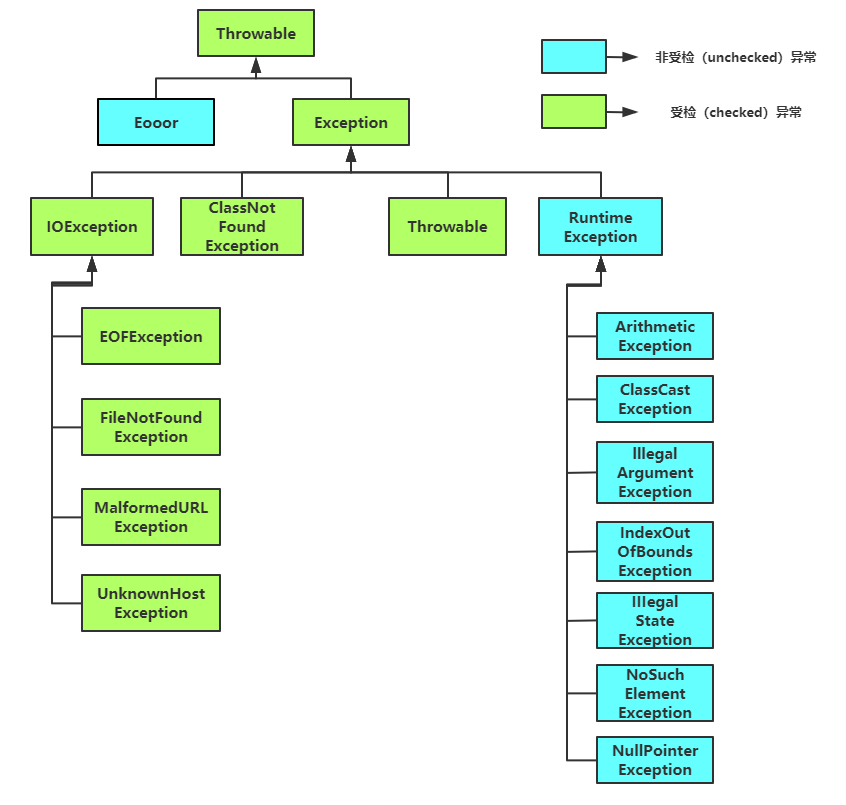在Java中,将程序执行中发生的不正常的情况称之为“异常 ”,(语法错误与逻辑错误不是异常)
Java程序在执行过程中发生的异常可以分为两类:
- Error:Java虚拟机无法解决的问题,如
- StackOverflowError(栈溢出)
- OOM(内存溢出)
- Exception:由于编程错误或者偶然的外在因素导致的一般性问题,如
- 空指针
- 读取不存在的文件
- 数组越界
- 网络问题
一、Java异常体系结构
- 编译型异常:checked
- 运行时异常:unchecked


二、常见异常
运行时异常
2.1 NullPointerException
@Test
public void test1() {
String a = null;
System.out.println(a.charAt(0));
}
2.2 ArrayIndexOutBoundsException
@Test
public void test2() {
int[] arr = new int[10];
System.out.println(arr[10]);
}
2.3 ClassCastException
@Test
public void test3() {
Object date = new Date();
String str = (String) date;
}
2.4 NumberFormatException
@Test
public void test4() {
String str = "123";
str = "ABC";
int i = Integer.parseInt(str);
}
2.5 InputMismatchException
@Test
public void test5() {
Scanner scanner = new Scanner(System.in);
scanner.nextInt();
}
2.6 ArithmeticException
@Test
public void test6() {
int a = 0;
int b = 2;
System.out.println(b / a);
}
编译时异常
@Test
public void test7() {
File file = new File("hello.txt");
FileInputStream fileInputStream = new FileInputStream(file);
int data = fileInputStream.read();
while (data != -1) {
System.out.println((char)data);
data = fileInputStream.read();
}
fileInputStream.close();
}
三、异常处理机制
Java对于异常的处理:抓抛模型
- 抛:程序执行中,一旦出现异常,就在异常代码处生成一个对应异常类的对象。并将对象抛出,一旦抛出对象,其后面的代码就不再执行
- 抓:异常的处理方式:1.try-catch-finally 2.throws
3.1 try-catch-finally
- finally可选,其声明的是一定会执行的代码,像JVM不能自动回收,手动资源释放需要声明在finally中
- 使用try将可能出现的异常代码包装起来,在执行过程中,一旦出现异常,就会生成一个对应异常类的对象,根据此对象的类型,去catch中进行匹配
- 一旦try的异常对象匹配到某一个catch时,就进入catch中进行异常的处理,处理完成就退出
- catch中异常类型若没有子父类关系,则无序,若有关系,则子类必须在父类前面,否则会报错
- 常用的异常对象处理方式: 1. String getMessage() 2. printStackTrace()
@Test
public void test1() {
String str = "123";
str = "abc";
try{
int num = Integer.parseInt(str);
}catch (NullPointerException e) {
System.out.println("出现空指针异常");
}catch (NumberFormatException e) {
System.out.println("出现数值转换异常");
}catch (Exception e) {
System.out.println("出现异常!");
}
...
finally {
//一定会执行的代码
}
}
总结:使用 try-catch-finally处理编译时异常,使得程序在编译时不再报错,但是运行时仍然可能报错
3.2 throws
- “ throws + 异常类型 ” 写在方法的声明处,指明此方法执行时,可能会抛出的异常类型。一旦当方法体执行时,出现异常仍会在异常代码处生成一个异常类的对象,此对象满足throws后异常类型时,就会被抛出
四、自定义异常类
在开发中根据自己业务的异常情况来定义异常类
-
自定义一个编译期异常: 自定义类 并继承于 java.lang.Exception
-
自定义一个运行时期的异常类:自定义类 并继承于 java.lang.RuntimeException